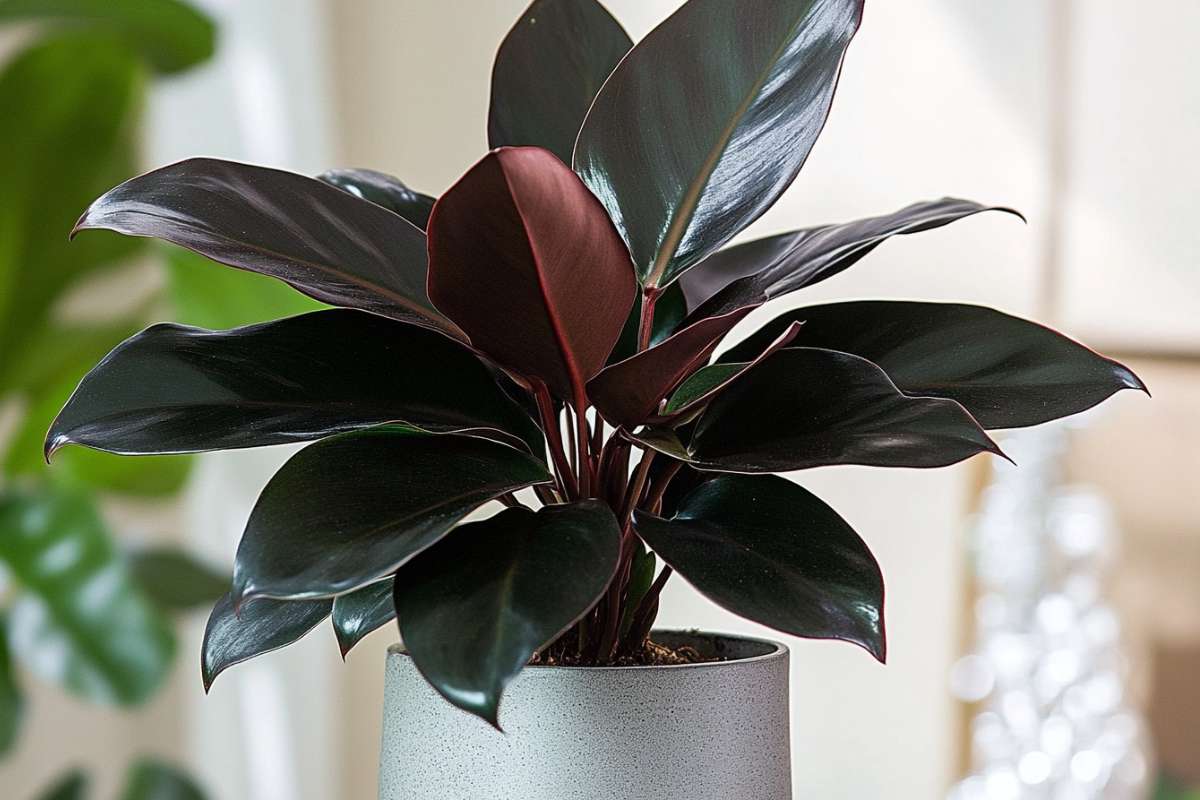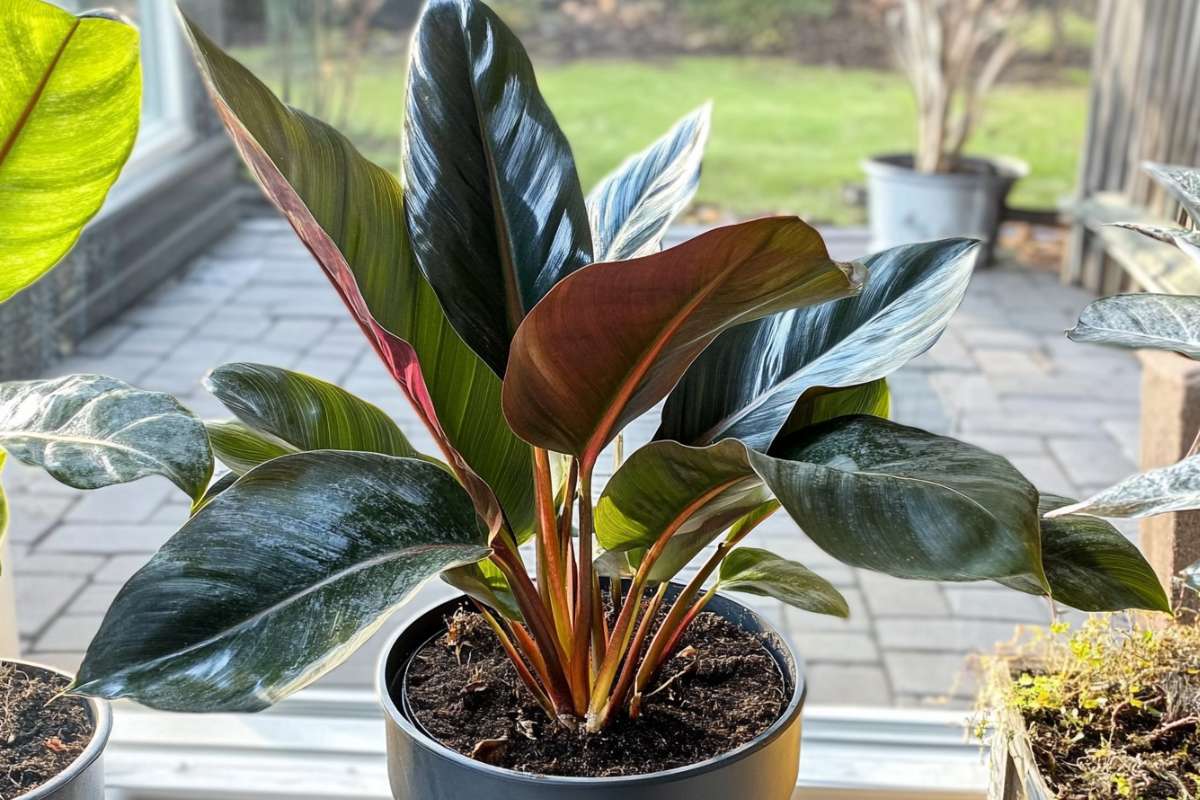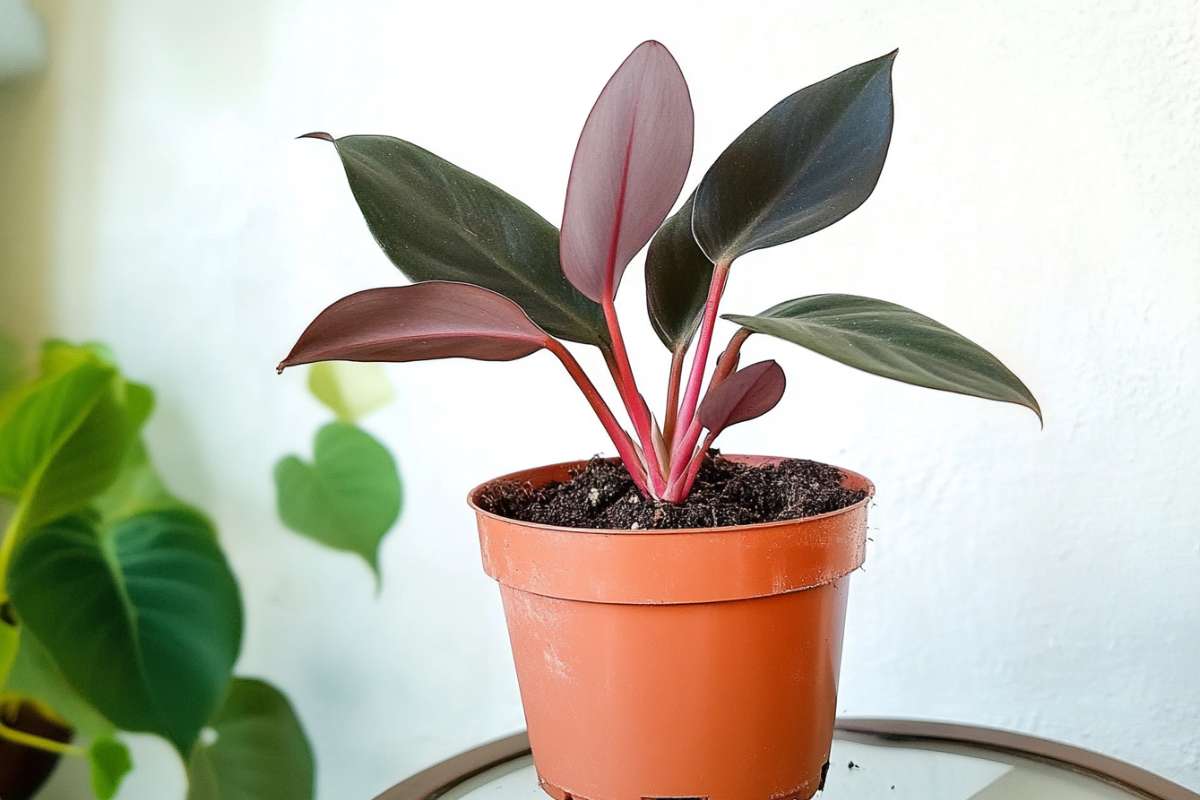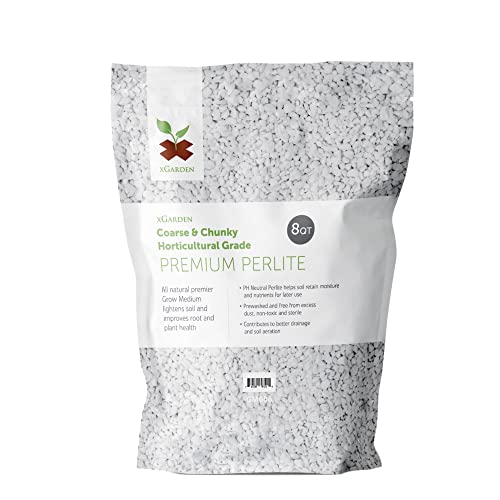Want to add a unique touch to your home garden? The Philodendron Black Cardinal is a great pick. Its dark, shiny leaves stand out, and it’s easy to take care of, even if you’re just starting with plants.
This guide will show you how to keep your Philodendron Black Cardinal thriving. You’ll find out about the best soil for it, how much light it needs, and the right way to water it. We’ll also go over common issues and how to fix them.
Are you ready to add some dark elegance to your space? Caring for this beautiful plant is simpler than you might think. Let’s dive into the details.
5 Key Takeaways on Philodendron Black Cardinal
- Philodendron Black Cardinal is a beautiful plant that features dark, glossy leaves that change color from bronze-orange to deep green-black as they mature.
- Place this lovely plant in bright, indirect sunlight and rotate it regularly to ensure even growth.
- Water your Philodendron Black Cardinal when the top inch of soil feels dry to prevent root rot.
- Maintain a warm environment (65°F to 80°F) with 50% to 70% humidity for this tropical plant to thrive.
- Keep this plant out of reach of pets, as it contains calcium oxalate crystals that can be harmful if ingested.
Philodendron Black Cardinal Overview

The Philodendron Black Cardinal is one of my favorite indoor plants to grow with its dark, aesthetic appeal and compact size. This plant, a member of the Araceae family, comes from the warm, tropical areas of South and Central America.
This table provides a quick overview of the Black Cardinal’s appearance:
| Characteristic | Description |
|---|---|
| Leaf Shape | Broad and oval with a pointed tip |
| Leaf Color | Dark green to nearly black |
| Leaf Size | 12-18 inches long and 6-8 inches wide |
| Leaf Texture | Glossy and smooth |
| Plant Height | 2-3 feet tall when grown indoors |
| Veins | Light green to yellow, contrasting with the dark leaf |
I keep my plant in a warm spot — it loves temperatures between 65°F and 80°F (18°C to 27°C). Like other philodendron varieties, it’s not a fan of the cold, so I make sure to shield it from chilly drafts and sudden temperature changes.
This plant makes it a fantastic pick for indoor gardens or any spot where space is tight. If you’re looking to add a touch of dark elegance to your home, the Philodendron Black Cardinal is a great choice.
Philodendron Black Cardinal Care Guide
Thinking about growing a Philodendron Black Cardinal but unsure where to begin? Don’t worry! I’ll teach you the basics like choosing the right soil, providing the best light, watering correctly, and handling any issues.
Let’s keep your Philodendron Black Cardinal healthy and look fantastic.
Philodendron Black Cardinal Soil Requirements
For my Philodendron Black Cardinal, I found out that the right soil mix is super important to keep it healthy. The tip is to use a well-draining potting mix. This way, the roots don’t sit in water, which can cause rot.
Here’s the mix I use for my philodendron black cardinal:
- Nutrient-Rich Potting Soil – This is the base that feeds the plant.
- Coarse Perlite or Organic Coco Coir – These help with drainage and keep the soil from getting too compact.
- Orchid Bark – This adds to the aeration, making sure the roots get plenty of air.
Using this mix means my plant gets the moisture it needs without the risk of root rot.
Philodendron Black Cardinal Light Requirements

Philodendron Black Cardinal loves bright, indirect light. It does okay in lower light, but for the best growth and to keep those leaves looking their best, here’s what I do:
I place mine near the east or west windows. This spot gives the right amount of light without burning the leaves.
Direct sunlight is a no-go because it can scorch the leaves. To keep my plant growing evenly and not leaning to one side, I rotate it regularly.
This simple trick makes sure all sides get enough light absorption.
Philodendron Black Cardinal Watering and Humidity Requirements
The Philodendron Black Cardinal loves its soil to be moist but not soaked. I water it when the top couple of inches of soil feel dry. It’s important to have a pot with drainage holes so the plant doesn’t sit in water.
This plant thrives in humidity levels of 50% to 70%. To keep the air around it nice and steamy, I either use a humidifier or give the leaves a good misting. Another trick is putting the pot on a tray with pebbles and water. As the water evaporates, it creates a cozy, humid spot for the plant.
Fertilizer for the Philodendron Black Cardinal
Using a high-nitrogen fertilizer at half-strength every few weeks during the growing season, which is spring to summer, is what I recommend for the Philodendron Black Cardinal. This really helps the plant grow strong and keeps those leaves looking stunning.
You can also look for a balanced fertilizer like a 10-10-10 or 20-20-20 mix. These numbers show that the fertilizer has all the main nutrients the plant needs.
It’s super important to fertilize when the soil is moist. Doing it on dry soil can hurt the roots, and that’s not good for the plant. For fall and winter, cut back to once a month or even less since the plant doesn’t grow as much then.
Always watch for signs your plant might need more nutrients, like yellow leaves or slow growth. If you see that, it might be time for a little extra fertilizer.
How to Prune the Philodendron Black Cardinal
Philodendron Black Cardinal doesn’t need a lot of cutting back like some others do since it grows compactly. But a little regular care goes a long way in keeping it lush and promoting growth.
You can start by snipping off any dead or yellow leaves. They don’t just look bad, they can also invite pests or sickness. Use sharp, clean scissors to make the cuts. This way, you avoid hurting the plant.
If the plant gets too full, think about dividing it. This helps air move around better, cutting down the chance of fungus and making sure all parts get enough light.
Pruning is also a chance to shape your plant. If some stems are longer, trim them to make the plant look more even. Just be careful not to overdo it. Too much pruning can stress your plant and slow its growth.
How to Repot the Philodendron Black Cardinal

Repotting my Philodendron Black Cardinal is something I do to help it keep growing strong. This plant loves a well-draining potting mix, but over time, the mix can get packed down. I try to repot it every 1-2 years or whenever I see the roots getting too big for the pot.
Follow these steps to repot your Philodendron Black Cardinal:
- Go for a pot that’s just a bit bigger than the one your plant’s in now. Make sure it has holes at the bottom for water to drain out.
- Mix potting soil, orchid bark, and perlite. This combo helps air move around and stops the soil from getting too wet.
- Carefully lift your plant out of its old pot. Be gentle with the roots.
- If the roots are all bunched up, gently pull them apart. This helps the plant grow better.
- Place your plant in the new pot and add the fresh soil mix around it.
- Give your plant a good drink. The soil should be wet but not sitting in water.
- Put the plant in a spot where it gets bright, indirect light. This helps it get used to its new home.
- Keep an eye on how wet the soil is and change how much you water if you need to. Plants might need more water right after you move them.
How to Propagate the Philodendron Black Cardinal
Propagating a Philodendron Black Cardinal is something I find rewarding, and I think you’ll enjoy it too. You can do it through stem cuttings, which is a pretty straightforward process. The ideal time to start is during the growing season when the plant is full of life.
Here’s how I do it:
- Pick a healthy stem that has a few leaves on it. Using clean, sharp scissors
- Cut a piece that’s about 4-6 inches long.
- After that, remove the lower leaves to show the nodes. These nodes are super important because they’re where the roots will grow from.
Now, you have two options for rooting: water or soil.
Water propagation steps:
- Make sure the nodes are submerged but the leaves stay dry.
- Change the water every week to keep it fresh.
- In about 2-4 weeks, you will start start to see roots.
Soil propagation steps:
- Fill a small pot with a mix that drains well.
- Bury the nodes in the soil and water it lightly.
- Then, cover the pot with a plastic bag or a clear dome to keep the humidity high until the roots grow.
- After a few weeks, remove the cover and treat the new plant like a grown-up Philodendron Black Cardinal.
This method of propagation is also a great way to learn about root development and how plants grow. Plus, it’s super satisfying to see your efforts turn into a new, thriving plant.
Philodendron Black Cardinal Common Problems, Pests, and Diseases
The Philodendron Black Cardinal is a tough plant but it can still run into some issues like pests and diseases. Here are the main problems you might face and how to fix them:
- Overwatering – Too much water can cause root rot. Make sure the soil dries out between waterings to keep the roots healthy.
- Pests – Watch out for spider mites, aphids, and mealybugs. Check your plant regularly. If you see any pests, insecticidal soap will help get rid of them.
- Yellowing Leaves – If the leaves turn yellow, it could be from too much water, not enough nutrients, or not enough light. You might need to change how you fertilize or give light to the plant.
- Leaf Scorch – Direct sunlight can burn the leaves. Keep the plant in bright, indirect light to prevent this.
- Fungal Diseases – These happen when there’s not enough air circulation. Pruning the plant and not overcrowding it can help.
- Drooping Leaves -This could mean the plant needs more water or less. Check the soil and adjust your watering.
Wiping the leaves with a damp cloth keeps the Philodendron Black Cardinal healthy and free from pests. You’ll find that these are common issues you need to address when growing Philodendrons in general.
Is Philodendron Black Cardinal Toxic to Pets?
The Philodendron Black Cardinal can be harmful to pets, especially cats and dogs. It has calcium oxalate crystals that might irritate them if they eat part of the plant. If your pet gets sick, like drooling or throwing up, or has trouble swallowing, it’s important to call your vet right away.
To keep your pets safe, it’s best to put this plant where they can’t reach it. Even though this plant looks great in any home, pet owners need to be careful.
Philodendron Black Cardinal Care Final Thoughts
The Philodendron Black Cardinal adds dark elegance to any home. Its glossy leaves stand out, and it’s easy to care for, making it a hit with both new and seasoned plant parents.
To help it thrive, focus on the right soil, light, and humidity level. Keep up with pruning and repotting to maintain its health. Also, make sure it’s out of pets’ reach for safety. Follow these tips, and your Philodendron Black Cardinal will be a beautiful focal point in your space.
Philodendron Black Cardinal Care FAQs
1. How Big Does a Philodendron Black Cardinal Get?
Philodendron Black Cardinal plants usually grow to be about 1.5 to 3 feet long. But if you plant them outside where they have lots of space and light, they can get really big, up to 6 to 8 feet tall. Their leaves are pretty large too, around 12 inches long and 8 inches wide.
2. Why Is My Philodendron Black Cardinal Dying?
If your Philodendron Black Cardinal isn’t thriving, it might not be getting enough light or you could be overwatering it. This plant needs at least six hours of bright, indirect light each day. Water only when the top few inches of soil feel dry.
3. How to Tell If Your Black Cardinal Plant Is Getting Enough Bright Indirect Light?
Check out the leaves’ color. Yellow leaves might mean the plant needs more light. Young plants show off shiny, green leaves. As they age, these leaves shift to a deeper red-brown or black.
For other great houseplants and how to care for them, check these articles out:
- Philodendron Xanadu Grow and Care
- Caring for Philodendron Billietiae
- Guide to Philodendron Birkin Care
- Grow Philodendron Black Knights
- https://aggie-hort.tamu.edu/databases/interiorscape/Philodendron.html
- https://www.extension.iastate.edu/news/yard-and-garden-growing-philodendrons
- https://hgic.clemson.edu/factsheet/philodendron-pothos-monstera/
- https://mrec.ifas.ufl.edu/Foliage/folnotes/philo-sh.htm
- https://edis.ifas.ufl.edu/publication/EP150
- https://jcra.ncsu.edu/resources/photographs/results-photograph-file-name.php
- https://yardandgarden.extension.iastate.edu/faq/what-are-popular-types-philodendron





